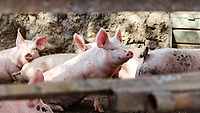Good News From USDA: U.S. Pork Supply Free of Trichinella Parasite

Image credit: Mark Stebnicki via Pexels
Following a survey of 3.2 million pigs raised under the U.S. Pork Quality Assurance Plus (PQA+) program, the U.S. Department of Agriculture (USDA) has announced a total absence of Trichinella infections in the national pork supply. Trichinella is a parasite that once posed a major food safety risk to the commercial pork supply, but is now negligible to public health, thanks to decades of effort to control this parasite, both nationally and internationally.
The U.S. does not perform post-slaughter testing for Trichinella in the pork supply. While modern production systems followed by U.S pork producers effectively minimize risk of exposure to the parasite, absence of Trichinella infection has never been verified through national testing—until it was demonstrated by the present survey.
USDA researchers conducted this survey to ascertain whether the PQA+ program eliminates the risk of Trichinella exposure in commercial pork. The PQA+ program is an education and certification program designed by the U.S. pork industry to help pig farmers and their employees continually improve production practices. At present, more than 63,000 U.S. pork producers are certified under PQA+.
Based on USDA scientific research and in harmony with World Health Organization (WHO) guidelines, Trichinella mitigation measures promoted by the PQA+ program include:
- Following proper feed biosecurity protocols
- Preventing exposure to rodents, wildlife, and birds
- Refraining from feeding raw food waste of animal origin to swine
- Promptly removing and properly disposing of swine carcasses
- Documenting animal arrivals and departures from PQA+ production sites.
In the USDA survey, a total of 3,208,643 animals across twelve processing locations were tested over a period of 54 months; more specifically, 11 U.S. pork processing companies, comprising 30 locations in 12 states, participated in the survey. Trichinella was not detected in any of the diagnostic samples, providing a 95 percent confidence in a Trichinella prevalence of less than 1 in 1,000,000 pigs.
Looking for a reprint of this article?
From high-res PDFs to custom plaques, order your copy today!






